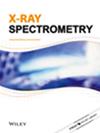A field‐based evaluation of portable XRF to screen for toxic metals in seafood products
IF 1.5
4区 物理与天体物理
Q3 SPECTROSCOPY
引用次数: 0
Abstract
Abstract Portable X‐Ray Fluorescence (XRF) has become increasingly popular where traditional laboratory methods are either impractical, time consuming, and/or too costly. While the Limit of Detection (LOD) is generally poorer for XRF compared to laboratory‐based methods, recent advances have improved XRF LODs and increased its potential for field‐based studies. Portable XRF can be used to screen food products for toxic elements such as lead (Pb), cadmium (Cd), mercury (Hg), arsenic (As), manganese, (Mn), zinc (Zn), and strontium (Sr). In this study, 23 seafood samples were analyzed using portable XRF in a home setting. After XRF measurements were completed in each home, the same samples were transferred to the laboratory for re‐analysis using microwave‐assisted digestion and Inductively Coupled Plasma Tandem Mass Spectrometry (ICP‐MS/MS). Four elements (Mn, Sr, As, and Zn) were quantifiable by XRF in most samples, and those results were compared to those obtained by ICP‐MS/MS. Agreement was judged reasonable for Mn, Sr, and As, but not for Zn. Discrepancies could be due to (1) the limited time available to prepare field samples for XRF, (2) the heterogeneous nature of “real samples” analyzed by XRF, and (3) the small beam spot size (~1 mm) of the XRF analyzer. Portable XRF is a cost‐effective screening tool for public health investigations involving exposure to toxic metals. It is important for practitioners untrained in XRF spectrometry to (1) recognize the limitations of portable instrumentation, (2) include validation data for each specific analyte(s) measured, and (3) ensure personnel have some training in sample preparation techniques for field‐based XRF analyses.便携式XRF用于筛选海产品中有毒金属的现场评价
便携式X射线荧光(XRF)已经变得越来越流行,传统的实验室方法要么不切实际,耗时,和/或太昂贵。虽然与基于实验室的方法相比,XRF的检测限(LOD)通常较差,但最近的进展已经改善了XRF的LOD,并增加了其基于现场研究的潜力。便携式XRF可用于筛选食品中的有毒元素,如铅(Pb)、镉(Cd)、汞(Hg)、砷(as)、锰(Mn)、锌(Zn)和锶(Sr)。在本研究中,使用便携式XRF在家庭环境中分析了23份海鲜样品。在每个家庭完成XRF测量后,相同的样品被转移到实验室,使用微波辅助消解和电感耦合等离子体串联质谱(ICP - MS/MS)进行重新分析。在大多数样品中,XRF可定量测定四种元素(Mn, Sr, As和Zn),并将这些结果与ICP‐MS/MS所得结果进行比较。Mn、Sr和As的一致性被认为是合理的,但Zn的一致性不合理。差异可能是由于(1)准备XRF现场样品的时间有限,(2)XRF分析的“实际样品”的异质性,以及(3)XRF分析仪的光束光斑尺寸小(~1 mm)。便携式XRF是一种具有成本效益的筛查工具,用于涉及有毒金属暴露的公共卫生调查。对于未接受过XRF光谱分析培训的从业者来说,重要的是要(1)认识到便携式仪器的局限性,(2)包括所测量的每种特定分析物的验证数据,以及(3)确保人员在基于现场的XRF分析的样品制备技术方面接受过一些培训。
本文章由计算机程序翻译,如有差异,请以英文原文为准。
求助全文
约1分钟内获得全文
求助全文
来源期刊

X-Ray Spectrometry
物理-光谱学
CiteScore
3.10
自引率
8.30%
发文量
38
审稿时长
6-12 weeks
期刊介绍:
X-Ray Spectrometry is devoted to the rapid publication of papers dealing with the theory and application of x-ray spectrometry using electron, x-ray photon, proton, γ and γ-x sources.
Covering advances in techniques, methods and equipment, this established journal provides the ideal platform for the discussion of more sophisticated X-ray analytical methods.
Both wavelength and energy dispersion systems are covered together with a range of data handling methods, from the most simple to very sophisticated software programs. Papers dealing with the application of x-ray spectrometric methods for structural analysis are also featured as well as applications papers covering a wide range of areas such as environmental analysis and monitoring, art and archaelogical studies, mineralogy, forensics, geology, surface science and materials analysis, biomedical and pharmaceutical applications.
 求助内容:
求助内容: 应助结果提醒方式:
应助结果提醒方式:


